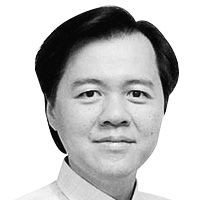Who can resist eating fatty foods?

A few weeks ago, I wrote about the “Top 10 not-so-healthy foods (we love to eat).” I casually mentioned that these foods need to be taken in moderation.
The not-so-healthy list includes: 1) pork fat in lechon, crispy pata, and pata tim, 2) pork chicharon and chicharon bulaklak, 3) organ innards, like bopis, 4) street food, 5) half-cooked meat, 6) junk foods, 7) alcoholic drinks, 8) fatty sauces like gravy, mayonnaise, 9) French fries, and 10) sweetened beverages.
However, our STAR readers’ reaction could be violent and amusing. Here are a few of the comments I received:
“I might as well die if I cannot eat these foods. LOL!” — Mr. M. (Sorry, Mr. M., I just said to limit your intake.)
“I think there is a thing called moderation, right? The world is risky, yes; most of the time, delicious foods are fatty.” — Mr. P.
“A wake-up call for everyone. I think we already know that these foods are really unhealthy, but we still eat most of them. What is bad for you is hard to resist.” — Ms. D.
Reducing The Filipino’s Fat Intake
Looking at our readers’ reactions, is there another way we can avoid these fatty foods? Maybe there is. Let me tell you a story.
Butsoy, a chubby five-year-old boy, went to a restaurant with his parents, and they ordered him his favorite pork chops. As the sizzling, mouthwatering dish arrived, our little friend skillfully proceeded to separate all the fat from the meat. A lady happened to notice and remarked, “What a fine, health-conscious boy! He’s removing all those unhealthy fats.” In an instant, Butsoy gobbled up all the fat and left the meat untouched.
Next to smoking, high cholesterol is probably the most important risk factor for heart disease. We are all aware of the dangers of fat and how it clogs our arteries, leading to a heart attack or a stroke. Yet despite health articles on the evils of excess fat, the Filipino’s fat intake is still high.
There are basically two ways to reduce fat intake. The first strategy is through health promotion (telling a person not to eat the fat). The second strategy is by health protection (the government enacts laws to separate fat from the meat before it reaches the consumers). Let us look at both ways.
Health Promotion: Avoid The Fat
For the first strategy, we can so decide, by sheer strength of will power, to limit our fat intake. We can try to avoid delectable foods such as lechon, chicharon, gravies, and mayonnaise dressings.
A few strong-willed individuals have enviably kept their fat intake down, and maintained a slim figure. But for the majority of people, fat is difficult to resist. It is tastier, more aromatic, and more intoxicating than dry lean meat. A restaurant owner will tell you: Serve the fat and people will come.
Here, we face the problem of choice. The issue is: Does Butsoy, or anyone else for that matter, really have a choice if his senses are constantly being enticed with fatty cuisines? If not, then is it possible to remove the fat before it reaches our plates?
Health Protection: Anti-Fat Policy
What if we consider a policy that effectively forces meat dealers to separate the fat from lean meat of beef and pork before selling them in the markets? The trimmed fat can then be sold separately at a higher price or fat may be used for alternative purposes. This is the concept of health protection.
To get further into this thinking, we foresee such policy to affect several sectors: the Bureau of Animal Industry, the livestock breeders, the meat dealers, the market vendors, the restaurant owners, and the canning factories.
For example, we can encourage livestock breeders to change their feed so as to raise leaner pigs. Of course, I do not harbor any illusion of ever removing the swine as fiesta fare unless I want the meat dealers with their sharp knives running after me.
Despite some obstacles, a policy of beef and pork trimmings is feasible. Dr. Shah Ebrahim, noted American researcher, agrees that policies to reduce fat intake are more effective in reducing heart disease than simple health education and promotion.
Because of the obesity epidemic, the US has adopted measures to reduce their fat intake. It is hard to find fatty meat in American supermarkets as fats are trimmed before they reach the consumers. In some American schools, low-fat meat alternatives have replaced the usual hamburgers and steaks. It could work.
As you can see, we can whine about the sins of fat or we can protect our children from fat. Later this evening, I will be dining at my nephew’s birthday party. It will be in a popular restaurant serving lechon de leche (suckling pig). As much as I am happy to see my nephew, I am agonizing over seeing my temptress, the pig. As they serve us this succulent and tasty pork skin with sweet liver sauce, we have to ask ourselves, “Do we have a choice?”
* * *
Check out my previous articles on the “Top 20 Healthiest Pinoy Foods” at my blog at docwillieandliza.com. This totally opposite and healthy list includes nuts, coconuts, tea, soy products, wheat, sweet potatoes, oats, ginger, beans, ampalaya, water, apple, garlic, milk, banana, carrots, citrus fruits, tomatoes, oily fish, and green leafy vegetables. Eat more of these healthy foods and live longer!



















